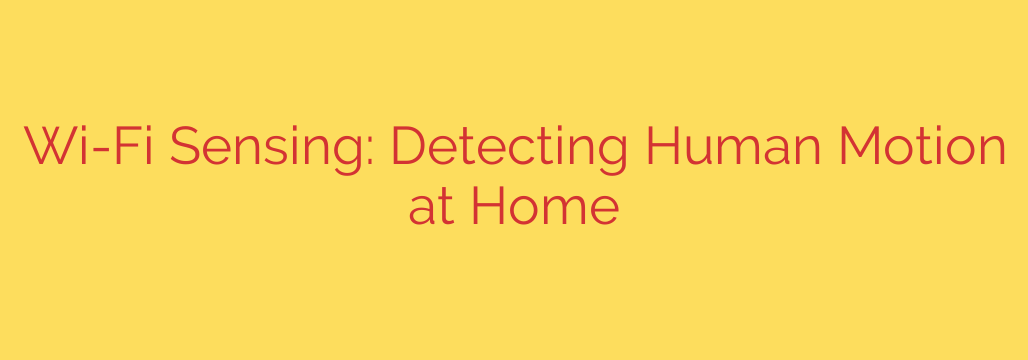
Your Wi-Fi Can See You: How Signal Sensing is Redefining Home Security
Imagine a home security system that can detect an intruder without a single camera. Picture a smart home that knows you’ve entered a room and turns on the lights, even in complete darkness. This isn’t science fiction; it’s the reality of an emerging technology known as Wi-Fi sensing. By harnessing the wireless signals already blanketing your home, this innovation is poised to change how we think about security, automation, and even personal wellness.
But how can invisible radio waves “see” you? It’s a revolutionary approach to motion detection that offers incredible benefits while raising important questions about privacy and security.
What is Wi-Fi Sensing? A Look Beyond Traditional Motion Detectors
For years, motion detection has relied on Passive Infrared (PIR) sensors, which detect changes in heat, or on video cameras powered by artificial intelligence. While effective, these methods have limitations. PIR sensors require a clear line of sight, and cameras can feel intrusive, capturing personal moments you’d rather keep private.
Wi-Fi sensing operates on a completely different principle. It uses your existing Wi-Fi network—your router and connected devices—to create an invisible net of signals throughout your space. Wi-Fi sensing technology works by analyzing how a person’s movement disturbs these signals.
Think of your home’s Wi-Fi as a calm pond. When you move through a room, you are like a stone dropped into the water, creating ripples. The system measures these “ripples” or disturbances in the Wi-Fi signals, specifically analyzing something called Channel State Information (CSI). Sophisticated algorithms interpret these minute changes in the signal to detect presence, motion, and even subtle actions like breathing.
The Science Behind the Signal: How Wi-Fi Detects Movement
At its core, Wi-Fi sensing doesn’t require new, specialized hardware. It leverages the equipment you already own. Here’s a simplified breakdown of how it works:
- A Stable Environment is Established: Your Wi-Fi router constantly sends signals to your connected devices (like your phone, smart TV, or laptop). When the room is empty, these signal paths are relatively stable.
- Movement Creates Disruption: When a person enters the area, their body reflects, absorbs, and scatters the Wi-Fi signals. This creates tiny, measurable fluctuations in the signal’s strength and path.
- Data is Analyzed: The system’s algorithms analyze these disruptions in real-time. By comparing the current signal pattern to the stable baseline, it can accurately determine that motion has occurred.
Because Wi-Fi signals pass through most common building materials, this technology can detect motion through walls, doors, and furniture, eliminating the blind spots that plague traditional sensors.
From Security to Wellness: Real-World Uses for Wi-Fi Sensing
The applications for this technology are vast and transformative, extending far beyond simple intrusion alerts.
- Enhanced Home Security: Detect intruders anywhere in the home, not just in specific zones. Since it doesn’t rely on cameras, it offers a completely private, invisible layer of security that works in any lighting condition.
- Seamless Smart Home Automation: Your home can react to your presence more intelligently. Lights can turn on when you enter a room and off when you leave, and your smart thermostat can adjust based on which parts of the house are occupied, saving energy without you lifting a finger.
- Elderly and Dependent Care: This is one of the most powerful applications. Wi-Fi sensing can monitor the well-being of an elderly relative without intrusive cameras. It can detect a fall, monitor sleep patterns, or alert a caregiver if there has been a lack of movement for an unusual period, providing peace of mind.
- Advanced Sleep Tracking: The technology is sensitive enough to detect the subtle movements of your chest as you breathe. This allows for highly accurate sleep tracking—monitoring sleep stages and respiratory rate—without requiring you to wear a smartwatch or place a sensor under your mattress.
Protecting Your Privacy in a Wi-Fi-Sensing World
While the benefits are clear, the idea of your Wi-Fi “watching” you can be unsettling. The key difference is that this technology detects anonymous motion, not identifiable images. However, as with any smart home technology, it’s crucial to be proactive about security.
Here are some actionable tips to ensure your data remains secure:
- Choose Reputable Brands: When this technology becomes more mainstream, opt for devices from well-known manufacturers who have clear, transparent privacy policies.
- Secure Your Network: The most important step is to protect your entire network. Use a strong, unique WPA3 password for your Wi-Fi and enable a network firewall if your router offers it.
- Keep Firmware Updated: Always install the latest firmware updates for your router and other smart devices. These updates often contain critical security patches that protect you from vulnerabilities.
- Manage Device Settings: Familiarize yourself with your router’s settings. You may be able to manage or disable sensing features if you are not comfortable using them.
Wi-Fi sensing represents a major leap forward in smart technology. By transforming your home’s wireless network into an intelligent motion detection system, it promises a future that is safer, more intuitive, and more connected than ever before.
Source: https://www.kaspersky.com/blog/wifi-sensing-motion-detection-howto/53851/








